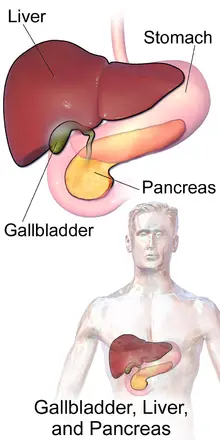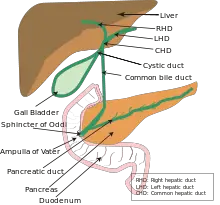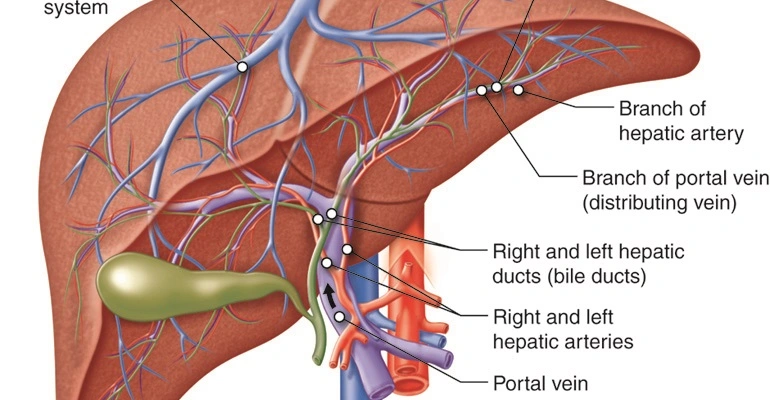Acute cholecystitis and acute cholangitis are both critical medical conditions that affect the biliary system, which plays a crucial role in the digestion and absorption of fats. While they share similarities in their symptoms and potential complications, these two conditions have distinct causes, diagnostic criteria, and management strategies. This essay aims to compare and contrast acute cholecystitis and acute cholangitis, shedding light on their clinical presentations, underlying mechanisms, diagnostic approaches, treatment options, and prognosis.
I. Acute Cholecystitis vs. Acute Cholangitis – Clinical Presentation:

A. Acute Cholecystitis: Acute cholecystitis is characterized by inflammation of the gallbladder, primarily due to the obstruction of the cystic duct by gallstones. Common symptoms include severe right upper quadrant abdominal pain, often radiating to the shoulder or back. Nausea, vomiting, fever, and tenderness in the gallbladder area are also typical signs.
B. Acute Cholangitis: Acute cholangitis refers to the inflammation of the bile ducts, often caused by a bacterial infection resulting from biliary obstruction. Symptoms include right upper quadrant pain, fever, chills, jaundice (yellowing of the skin and eyes), and potential signs of sepsis, such as altered mental status and low blood pressure.
II. Acute Cholecystitis vs. Acute Cholangitis – Underlying Mechanisms:
A. Acute Cholecystitis: The main cause of acute cholecystitis is the obstruction of the cystic duct by gallstones, which can lead to bile stasis, increased pressure, and subsequent inflammation of the gallbladder wall. In some cases, infection may develop due to bacterial overgrowth.
B. Acute Cholangitis: Acute cholangitis results from a combination of bile duct obstruction and bacterial infection. Bile duct obstruction can be caused by gallstones, strictures, tumors, or other structural abnormalities. The stagnant bile provides an environment for bacterial growth, leading to infection and inflammation.
III. Acute Cholecystitis vs. Acute Cholangitis – Diagnostic Approaches:
A. Acute Cholecystitis: Diagnosing acute cholecystitis involves a combination of clinical assessment, physical examination, laboratory tests (elevated white blood cell count and liver enzymes), and imaging studies. Ultrasound and sometimes CT scans are used to visualize gallbladder inflammation and gallstones.
B. Acute Cholangitis: The diagnosis of acute cholangitis requires careful clinical evaluation, blood tests (elevated white blood cell count, liver enzymes, and bilirubin), and imaging studies. An essential diagnostic criterion is the presence of systemic signs of infection, such as fever and chills. Imaging modalities like ultrasound, MRI, or ERCP (endoscopic retrograde cholangiopancreatography) help visualize biliary obstruction and identify potential sources of infection.
IV. Acute Cholecystitis vs. Acute Cholangitis – Treatment Options:
A. Acute Cholecystitis: The primary treatment for acute cholecystitis is hospitalization, fasting, and intravenous fluids. Antibiotics are often administered to manage any associated infection. Surgery, usually a laparoscopic cholecystectomy, is recommended once the inflammation subsides to prevent future attacks.
B. Acute Cholangitis: Management of acute cholangitis involves hospitalization, aggressive fluid resuscitation, and broad-spectrum antibiotics to address the bacterial infection. Endoscopic intervention, such as ERCP, is often performed to relieve biliary obstruction and drain infected bile. In severe cases, surgical intervention may be necessary.
V. Acute Cholecystitis vs. Acute Cholangitis – Complications:
A. Acute Cholecystitis: Untreated or severe cases of acute cholecystitis can lead to a range of complications. These include gallbladder perforation, abscess formation, gangrene, or bile peritonitis. These complications often require emergency surgical intervention and can significantly impact the patient’s recovery timeline and overall prognosis.
B. Acute Cholangitis: Acute cholangitis, if not promptly treated, can result in severe complications such as sepsis, liver abscesses, and multiple organ dysfunction syndrome. The risk of developing life-threatening complications in acute cholangitis is relatively higher due to the potential for systemic infection resulting from bacterial overgrowth in the bile ducts.
VI. Acute Cholecystitis vs. Acute Cholangitis – Mortality Rates:
A. Acute Cholecystitis: Mortality rates associated with uncomplicated acute cholecystitis are relatively low. With timely medical intervention and appropriate surgical management, the majority of patients can recover fully. However, mortality rates can increase significantly if complications arise and are not promptly addressed.
B. Acute Cholangitis: Acute cholangitis carries a higher risk of mortality compared to acute cholecystitis due to its potential to lead to systemic infection and sepsis. Mortality rates can vary depending on the severity of the infection, the presence of underlying medical conditions, and the timely administration of appropriate antibiotics and interventions to relieve biliary obstruction.

VII. Acute Cholecystitis vs. Acute Cholangitis – Long-Term Outcomes:
A. Acute Cholecystitis: Patients who undergo successful surgical intervention for acute cholecystitis typically experience good long-term outcomes. After recovery from the acute episode, most individuals can resume their normal activities without long-lasting effects. The removal of the gallbladder (cholecystectomy) eliminates the risk of future cholecystitis episodes caused by gallstones.
B. Acute Cholangitis: Long-term outcomes in acute cholangitis are influenced by various factors, including the severity of the initial infection, the presence of underlying liver diseases, and the efficacy of interventions to manage biliary obstruction. Patients who receive timely and effective treatment have a better chance of avoiding long-term complications and achieving a satisfactory quality of life.
Conclusion:
In conclusion, acute cholecystitis and acute cholangitis are two distinct yet related medical conditions affecting the biliary system. While they share common symptoms like abdominal pain, they differ in their underlying mechanisms, diagnostic criteria, and treatment approaches. A thorough understanding of these conditions is crucial for healthcare professionals to provide accurate diagnoses and effective management strategies, ultimately ensuring the best possible outcomes for patients experiencing biliary system complications.
Summary Table: Comparing and Contrasting Acute Cholecystitis vs. Acute Cholangitis: Symptoms, Causes, Treatments, and Prognosis
| Aspect | Clinical Presentations | Underlying Mechanisms | Diagnostic Approaches | Treatment Options | Prognosis |
|---|---|---|---|---|---|
| Acute Cholecystitis | – Severe RUQ abdominal pain, often radiating | – Gallstone obstruction of cystic duct | – Clinical assessment | – Hospitalization, fasting, IV fluids | – Generally favorable |
| to the shoulder or back | – Bile stasis, pressure, inflammation | – Physical examination | – Antibiotics for infection | – Good long-term outcomes | |
| – Nausea, vomiting | – Laboratory tests (WBC, liver enzymes) | – Surgery (laparoscopic cholecystectomy) | – Low mortality rates | ||
| – Imaging studies (ultrasound, CT) | after inflammation subsides | – Complications may arise | |||
| Acute Cholangitis | – RUQ pain, fever, chills, jaundice | – Biliary obstruction and bacterial infection | – Clinical evaluation | – Hospitalization, aggressive fluid resuscitation | – Higher risk of complications and mortality |
| – Systemic signs of infection (fever, chills) | – Stagnant bile, bacterial overgrowth | – Blood tests (WBC, liver enzymes, bilirubin) | – Broad-spectrum antibiotics | – Mortality rates vary based on severity | |
| – Imaging studies (ultrasound, MRI, ERCP) | – Endoscopic interventions (ERCP) | of infection and timely intervention | |||
| to visualize biliary obstruction | to relieve biliary obstruction and drain | – Long-term outcomes influenced by severity | |||
| infected bile | of infection and underlying conditions |
Multiple Choice Practice Questions and Answers
Question 1: Which of the following conditions involves inflammation of the gallbladder?
A) Acute Cholecystitis B) Acute Cholangitis C) Chronic Pancreatitis D) Hepatocellular Carcinoma
Question 2: What is the primary cause of Acute Cholecystitis?
A) Bacterial infection of the bile ducts B) Gallstones obstructing the cystic duct C) Chronic alcohol consumption D) Autoimmune reaction in the gallbladder
Question 3: Which symptom is more characteristic of Acute Cholangitis than Acute Cholecystitis?
A) Right upper abdominal pain B) Jaundice (yellowing of skin and eyes) C) Nausea and vomiting D) Shoulder pain radiating to the back
Question 4: Which imaging technique is commonly used to diagnose both Acute Cholecystitis and Acute Cholangitis?
A) Magnetic Resonance Imaging (MRI) B) Positron Emission Tomography (PET) C) Electrocardiography (ECG) D) Ultrasonography (Ultrasound)
Question 5: Which of the following is a potential complication of untreated Acute Cholangitis?
A) Gallstone formation B) Liver abscess C) Gastric ulcer D) Hemorrhagic stroke
Question 6: What is the preferred initial treatment for Acute Cholecystitis?
A) Intravenous antibiotics B) Surgical removal of the gallbladder C) Endoscopic retrograde cholangiopancreatography (ERCP) D) Physical therapy
Question 7: In Acute Cholangitis, infection usually develops due to:
A) Viral invasion of the bile ducts B) Bacterial contamination of the stomach lining C) Obstruction of the common bile duct D) Excessive alcohol consumption
Question 8: Which condition may require urgent intervention to relieve bile duct obstruction and prevent sepsis?
A) Chronic Gastritis B) Gastroesophageal Reflux Disease (GERD) C) Acute Pancreatitis D) Acute Cholangitis
Question 9: What is a key difference between the prognosis of Acute Cholecystitis and Acute Cholangitis?
A) Acute Cholecystitis has a higher risk of liver damage. B) Acute Cholangitis is more likely to cause gallstone formation. C) Acute Cholecystitis has a higher mortality rate if left untreated. D) Acute Cholangitis is primarily a self-limiting condition.
Question 10: Which of the following interventions is often used to alleviate bile duct obstruction in Acute Cholangitis?
A) Administering over-the-counter painkillers B) Fasting for 24 hours C) Endoscopic retrograde cholangiopancreatography (ERCP) D) Increasing consumption of fatty foods
Answers and Explanations
Question 1: Which of the following conditions involves inflammation of the gallbladder?
Answer: A) Acute Cholecystitis
Explanation: Acute Cholecystitis refers to the inflammation of the gallbladder, usually caused by gallstones obstructing the cystic duct.
Question 2: What is the primary cause of Acute Cholecystitis?
Answer: B) Gallstones obstructing the cystic duct
Explanation: The primary cause of Acute Cholecystitis is the obstruction of the cystic duct by gallstones, leading to inflammation of the gallbladder.
Question 3: Which symptom is more characteristic of Acute Cholangitis than Acute Cholecystitis?
Answer: B) Jaundice (yellowing of skin and eyes)
Explanation: Jaundice, or yellowing of the skin and eyes, is a more characteristic symptom of Acute Cholangitis than Acute Cholecystitis. It occurs due to the buildup of bilirubin caused by bile duct obstruction.
Question 4: Which imaging technique is commonly used to diagnose both Acute Cholecystitis and Acute Cholangitis?
Answer: D) Ultrasonography (Ultrasound)
Explanation: Ultrasonography, or ultrasound, is a common imaging technique used to diagnose both Acute Cholecystitis and Acute Cholangitis. It can visualize gallstones, bile duct obstruction, and inflammation of the gallbladder.
Question 5: Which of the following is a potential complication of untreated Acute Cholangitis?
Answer: B) Liver abscess
Explanation: Liver abscess is a potential complication of untreated Acute Cholangitis. The infection can spread to the liver tissue, leading to the formation of an abscess.
Question 6: What is the preferred initial treatment for Acute Cholecystitis?
Answer: B) Surgical removal of the gallbladder
Explanation: The preferred initial treatment for Acute Cholecystitis is usually surgical removal of the gallbladder, known as cholecystectomy, especially in cases of severe inflammation or recurrent episodes.
Question 7: In Acute Cholangitis, infection usually develops due to:
Answer: C) Obstruction of the common bile duct
Explanation: In Acute Cholangitis, infection often develops due to the obstruction of the common bile duct, which allows bacteria to ascend from the intestine into the bile ducts.
Question 8: Which condition may require urgent intervention to relieve bile duct obstruction and prevent sepsis?
Answer: D) Acute Cholangitis
Explanation: Acute Cholangitis requires urgent intervention to relieve bile duct obstruction and prevent the spread of infection, which can lead to sepsis and other severe complications.
Question 9: What is a key difference between the prognosis of Acute Cholecystitis and Acute Cholangitis?
Answer: C) Acute Cholecystitis has a higher mortality rate if left untreated.
Explanation: Acute Cholecystitis has a higher mortality rate if left untreated due to the potential complications of infection, gangrene, or rupture of the gallbladder. Acute Cholangitis is also serious but can be managed more promptly.
Question 10: Which of the following interventions is often used to alleviate bile duct obstruction in Acute Cholangitis?
Answer: C) Endoscopic retrograde cholangiopancreatography (ERCP)
Explanation: Endoscopic retrograde cholangiopancreatography (ERCP) is often used to alleviate bile duct obstruction in Acute Cholangitis. It involves inserting a scope into the digestive tract to remove obstructions and restore normal bile flow.
Check out these popular articles 🙂
Circulatory System: Blood Flow Pathway Through the Heart
Ectoderm vs Endoderm vs Mesoderm
Circulatory System: Heart Structures and Functions
Ductus Arteriosus Vs Ductus Venosus Vs Foramen Ovale: Fetal Heart Circulation
Cardiac Arrhythmias: Definition, Types, Symptoms, and Prevention
Upper Vs Lower Respiratory System: Upper vs Lower Respiratory Tract Infections
Seven General Functions of the Respiratory System
Digestive System Anatomy: Diagram, Organs, Structures, and Functions
Kidney Embryology & Development: Easy Lesson
Psychology 101: Crowd Psychology and The Theory of Gustave Le Bon
Introduction to Evolution: Charles Darwin and Alfred Russel Wallace
Copyright © 2023 Moosmosis Organization: All Rights Reserved
All rights reserved. This essay first published on moosmosis.org or any portion thereof may not be reproduced or used in any manner whatsoever
without the express written permission of the publisher at moosmosis.org.

Please Like and Subscribe to our Email List at moosmosis.org, Facebook, Twitter, Youtube to support our open-access youth education initiatives! 🙂
Categories: anatomy, Biology, cell biology, education, health, medicine, stem, technology













My cousin got her gallbladder removed just two months ago for acute cholecystitis. Excellent article!
LikeLiked by 1 person
Thank you very much, Dr. Keys! Hope your cousin is doing well!
LikeLike
Superb essay.
LikeLiked by 1 person
Thank you very much, K.!
LikeLike